
Myoporum is a genus of flowering plants in the figwort family, Scrophulariaceae. There are 30 species in the genus, eighteen of which are endemic to Australia although others are endemic to Pacific Islands, including New Zealand, and one is endemic to two Indian Ocean islands. They are shrubs or small trees with leaves that are arranged alternately and have white, occasionally pink flowers and a fruit that is a drupe.

Eremophila bowmanii, also known as silver turkeybush, Bowman's poverty bush and flannel bush, is a flowering plant in the figwort family, Scrophulariaceae and is endemic to New South Wales and Queensland in Australia. It is a low to medium, spreading shrub with silvery-grey, hairy foliage and blue to lilac flowers, and sometimes grows in dense thickets with mulga.

Myoporum insulare, commonly known as common boobialla, native juniper, is a species of flowering plant in the figwort family Scrophulariaceae and is endemic to coastal areas of Australia. It is a shrub or small tree which grows on dunes and coastal cliffs, is very salt tolerant and widely used in horticulture.

Myoporum parvifolium, commonly known as creeping boobialla, creeping myoporum, dwarf native myrtle or small leaved myoporum is a plant in the figwort family, Scrophulariaceae. It is a low, spreading shrub with long, trailing stems and white, star-shaped flowers and is endemic to southern Australia including Flinders Island.
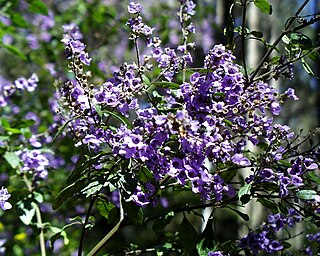
Prostanthera melissifolia, commonly known as balm mint bush, is a species of flowering plant in the family Lamiaceae and is endemic to south-eastern Australia. It is an erect shrub with hairy branches, egg-shaped leaves with fine teeth on the edges and mauve to purple or pink flowers on the ends of branchlets.

Phebalium nottii, commonly known as pink phebalium, is a species of shrub that is endemic to eastern Australia. It has branchlets with silvery scales, oblong to elliptical leaves, deep pink to mauve flowers arranged in umbels of up to six, with the stamens distinctively offset to one side of the flower.

Isopogon fletcheri, commonly known as Fletcher's drumsticks, is a species of plant in the family Proteaceae and is endemic to a restricted area in the Blue Mountains of New South Wales. It is a bushy shrub with narrow egg-shaped to narrow lance-shaped leaves with the narrower end towards the base, and top-shaped to egg-shaped heads of yellowish or creamy green flowers.

Myoporum acuminatum, commonly known as waterbush, pointed boobialla or mangrove boobialla, is a flowering plant in the figwort family Scrophulariaceae and is endemic to eastern Australia. It grows in rainforest or wet eucalyptus forest near the coast and in the Coastal Ranges, and is occasionally associated with mangroves. Occasionally it is found in the drier rainforests. It grows naturally as far south as Mimosa Rocks National Park in far south eastern New South Wales, and north to Fraser Island in Southern Queensland.
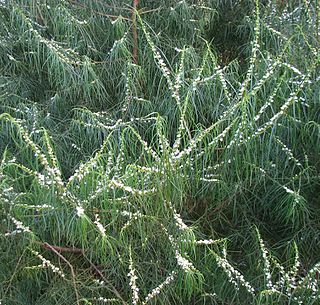
Myoporum floribundum, commonly known as weeping myoporum or slender myoporum, is a sour-smelling glabrous shrub in the family Scrophulariaceae endemic to a small area of New South Wales and Victoria in Australia. It has long, thin, drooping leaves and profuse white flowers in clusters along the stems in spring. Although it is uncommon in nature, it has long been available as a popular garden plant.

Myoporum montanum, commonly known as waterbush or boobialla, is a shrub native to Australia, New Guinea and Timor. The species is extremely variable in size growth habit and leaf form, with three primary forms recognised. Its occurrence in many places is restricted to coastal regions, watercourses and other locales with more reliable water supplies. It was this association with water that gave rise to the name water bush.
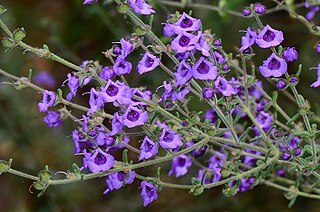
Prostanthera hirtula, commonly known as hairy mintbush, is a species of flowering plant in the family Lamiaceae and is endemic to the south-eastern continental Australia. It is a strongly aromatic, densely hairy, spreading shrub with narrow egg-shaped leaves and dark mauve flowers, and that grows in exposed, rocky sites.
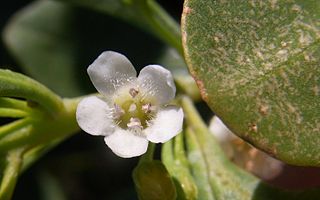
Myoporum boninense is a plant in the figwort family, Scrophulariaceae. It is a shrub with thick, fleshy, glossy leaves, white flowers in small groups and shiny lilac to pale purple fruits. It grows in coastal heath in New South Wales and Queensland in Australia and on islands in the north west Pacific Ocean.

Myoporum brevipes, commonly known as the pale myoporum, is a plant in the figwort family, Scrophulariaceae. It is sometimes a prostrate, others an erect shrub. Its branches and leaves are warty and it has white or pink flowers, often spotted, followed by succulent white fruits. It generally grows in arid areas in South Australia but has also been found in Victoria and Western Australia.
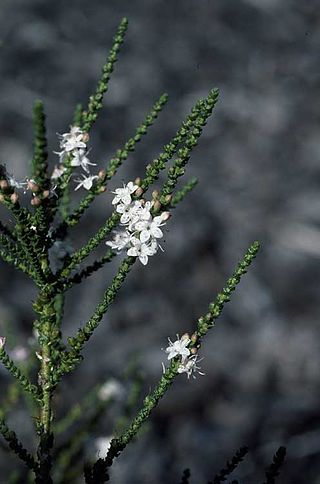
Myoporum cordifolium, commonly known as Jerramungup myoporum, is a plant in the figwort family, Scrophulariaceae. It is a shrub with thin, stiff branches and tiny, heart-shaped leaves, both covered with wart-like tubercles. Single white flowers with purple spots develop in the leaf axils and are followed by wrinkled green or brown fruits. It is endemic to a small area in the south-west of Western Australia
Glycocystis beckeri is the only species of the flowering plant genus Glycocystis in the family Scrophulariaceae and is endemic to the south west of Western Australia. It is a shrub, similar to others in the genera Eremophila and Myoporum but is unusual in that it produces very large amounts of sticky, sweet-smelling resin produced by raised glands which cover the entire plant, except for the petals. It has been suggested that the resin traps insects which the plant uses as a source of nitrogen.
Eremophila battii, also known as Batt's poverty bush, is a flowering plant in the figwort family, Scrophulariaceae and is endemic to central Australia. It is a low, spreading shrub with short, very hairy leaves and pink, purple or blue flowers.

Eremophila christophori, commonly known as dolomite fuchsia bush, is a flowering plant in the figwort family, Scrophulariaceae and is endemic to the southern part of the Northern Territory in Australia. It is an erect shrub with bright green leaves and white, pink or lilac flowers.
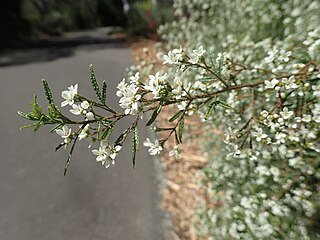
Zieria adenodonta, commonly known as the Wollumbin zieria, is a plant in the citrus family Rutaceae and is endemic to eastern Australia. It is a dense, bushy shrub with leaves composed of three leaflets which are warty on the upper surface. In winter and early spring it has groups of five to eight flowers, each with four white petals, the groups usually shorter than the leaves.

Prostanthera granitica, commonly known as the granite mintbush, is a species of flowering plant in the family Lamiaceae and is endemic to eastern Australia. It is a spreading shrub with egg-shaped leaves with the edges rolled under, and purple to violet flowers.
Pultenaea baeuerlenii, commonly known as Budawangs bush-pea, is a species of flowering plant in the family Fabaceae and is endemic to a restricted area of New South Wales. It is a small, erect shrub with linear, cylindrical, grooved leaves, and dense groups of yellow and red flowers, sometimes with red markings.

















